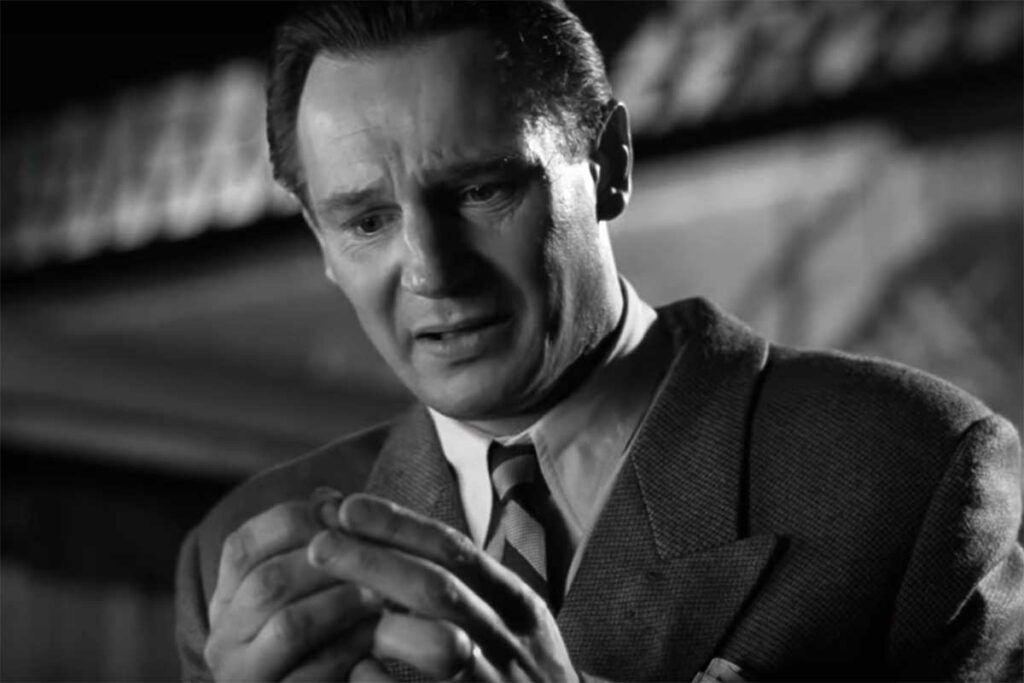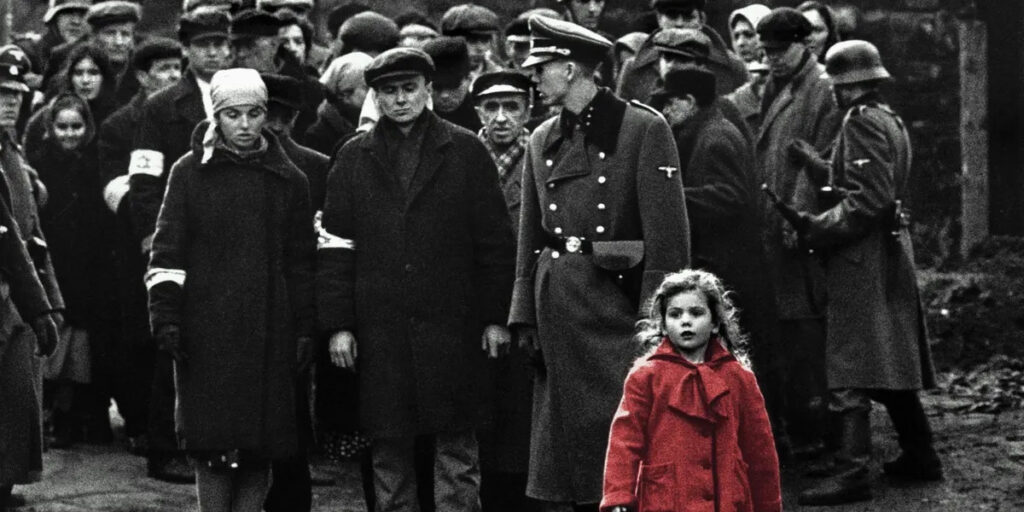Schindler’s List sees Spielberg take everything that he knows about blockbuster filmmaking and apply it to a heartbreaking story about war and heroism.
Although Spielberg is cited by many as one of the founding fathers of the ‘summer blockbuster’, the director’s talents shine just as brightly in his less populist, more mature films. Whether that’s his scathing condemnation of war in Saving Private Ryan or his prophetic examination of the future in Minority Report, Spielberg clearly has just as much of an eye for adult storytelling as he does for the family blockbuster. However, it’s with his sweeping wartime epic Schindler’s List that he so effortlessly applies all the revolutionary filmmaking techniques that he’s learned throughout his career and puts them to use with this tenderly heartbreaking analysis of war and its endless unavoidable consequences.
Schindler’s List tells the story of Oskar Schindler (Liam Neeson), a German industrialist who spent the majority of the Second World War as a member of the Nazi party and the director general of a large enamelware factory in occupied Poland. The film chronicles Oskar’s journey as he suffers a crisis of conscience after seeing the persecution of Jews in neighboring towns and decides to devote the rest of his life to saving the lives of those under his employment. It’s clearly a very solemn and weighted story, but Spielberg manages to navigate it with incredible care and always puts his characters at the forefront of the story. The film poses some extremely difficult and unanswerable questions to its audience, all the while putting forward a story that’s impossible to look away from – in spite of its uncomfortable and unsettling subject matter.
Perhaps what’s most impressive about Schindler’s List is just how captivating and gripping the film’s central narrative is. Many films have tried to navigate the tragedies of the Second World War like this, but none have ever been able to suck their audience in as effectively and effortlessly as Spielberg does here. The 3-hour runtime might feel daunting at first, but the film knows exactly how to make the most of every single second and uphold a compelling momentum from the very first frame until the moment the credits roll. Despite the fact that much of the film’s content consists simply of conversations and discussions between the main characters, Spielberg’s expertly layered writing prevents the film from ever becoming boring or uninteresting.

It also helps that Schindler’s List contains some of the most emotionally stirring performances of that entire decade, with Liam Neeson in particular standing out as the titular hero. He knows exactly how to navigate this morally ambiguous character, clearly displaying his selfishness and arrogance at the beginning of the film before subtly transforming himself into a man who becomes torn apart by the knowledge of who he used to be, and how much damage his actions in the past have caused. It’s one of the best character arcs ever put to screen, with Neeson’s performance tracking his complicated journey over three expertly-crafted hours of film. Beside Neeson is Ralph Fiennes, whose villainous performance as Nazi Commandant Amon Göth perfectly captures the toxic nationalism and brutality that allowed this whole war to happen in the first place. Fiennes becomes utterly despicable in the role, but his character plays a huge role in Schindler’s realization of the immorality displayed within the German military.
On top of the gripping story and the outstanding performances, Schindler’s List is also an extremely stylistic film that takes some bold decisions when it comes to its cinematography and direction. Almost the entire film is shot in a beautiful monochrome, which instantly transports the audience to the past and makes the whole story feel so much more authentic and grounded in reality. It’s full of crisp and striking images, but it’s the way that Spielberg constructs the film’s many memorable set pieces that’s truly mesmerizing. One of the film’s most haunting and unforgettable sequences involves the Nazi’s liquidation of a Jewish ghetto in Krakow, which features some chilling moments that sear their way into your brain and simply refuse to leave. It’s certainly not easy to watch, but the way Spielberg directs these sequences (along with many others in the film) is stunning, and the film’s extended runtime allows him to really drag out his scenes and linger on moments to make them more impactful.
It’s this dedication to authenticity that makes Schindler’s List stand out so prominently from other war dramas that deal with similar topics. Spielberg isn’t afraid to show the atrocities of war in all their grisly details, often opting to display the German army’s murderous crimes in a shockingly violent and disturbing way. It makes certain scenes incredibly difficult to watch, but at the same time it’s extremely effective at raising the stakes and building a deep connection between the audience and the story. Most won’t look at the world the same way after their first viewing of the movie, and although it might not be the most rewatchable and entertaining of Spielberg’s films, it’s undoubtedly his most powerful and important.
Schindler’s List was released on December 13, 1993, and is now available to watch on digital, on demand, and on DVD & Blu-Ray.

